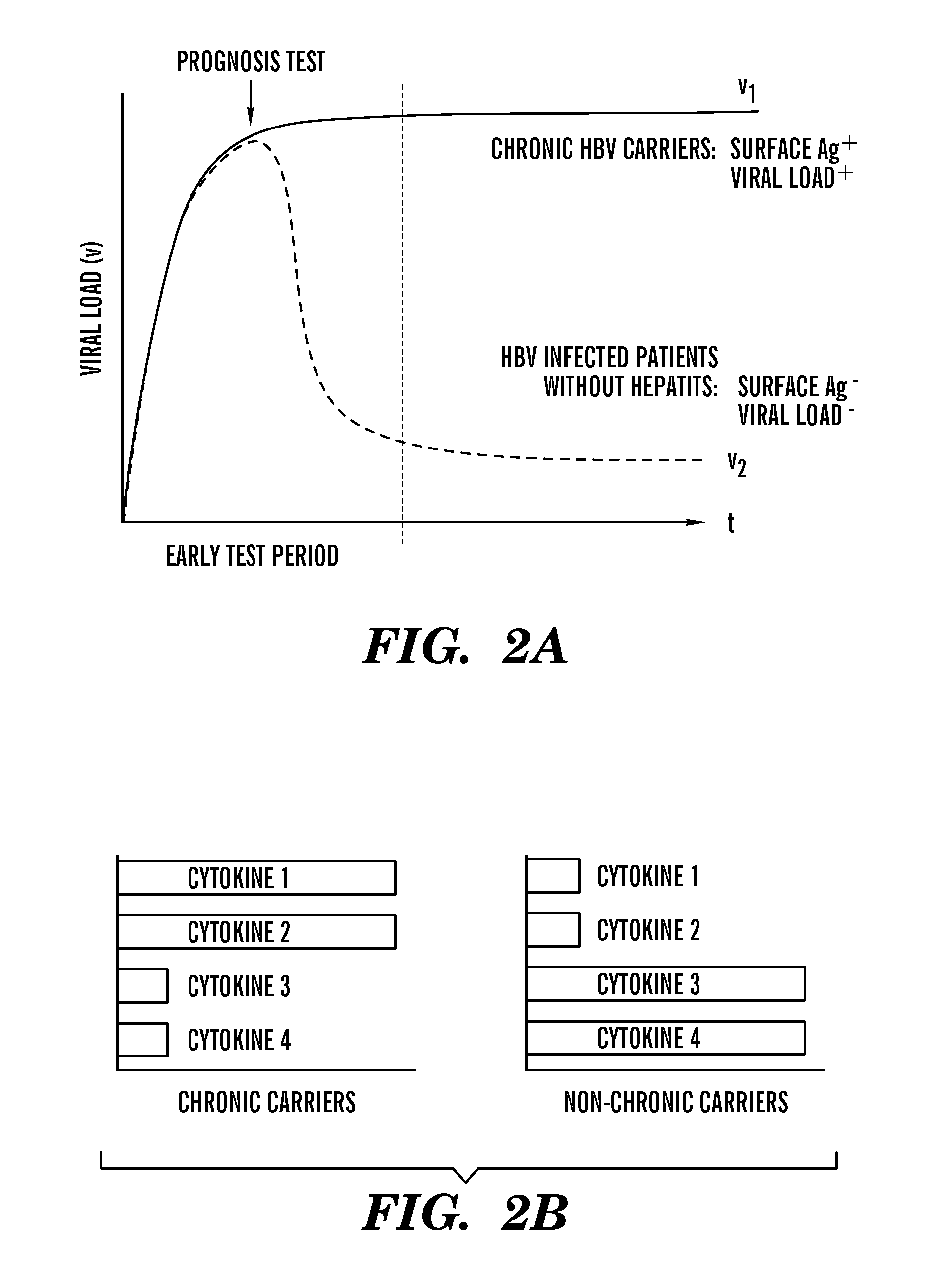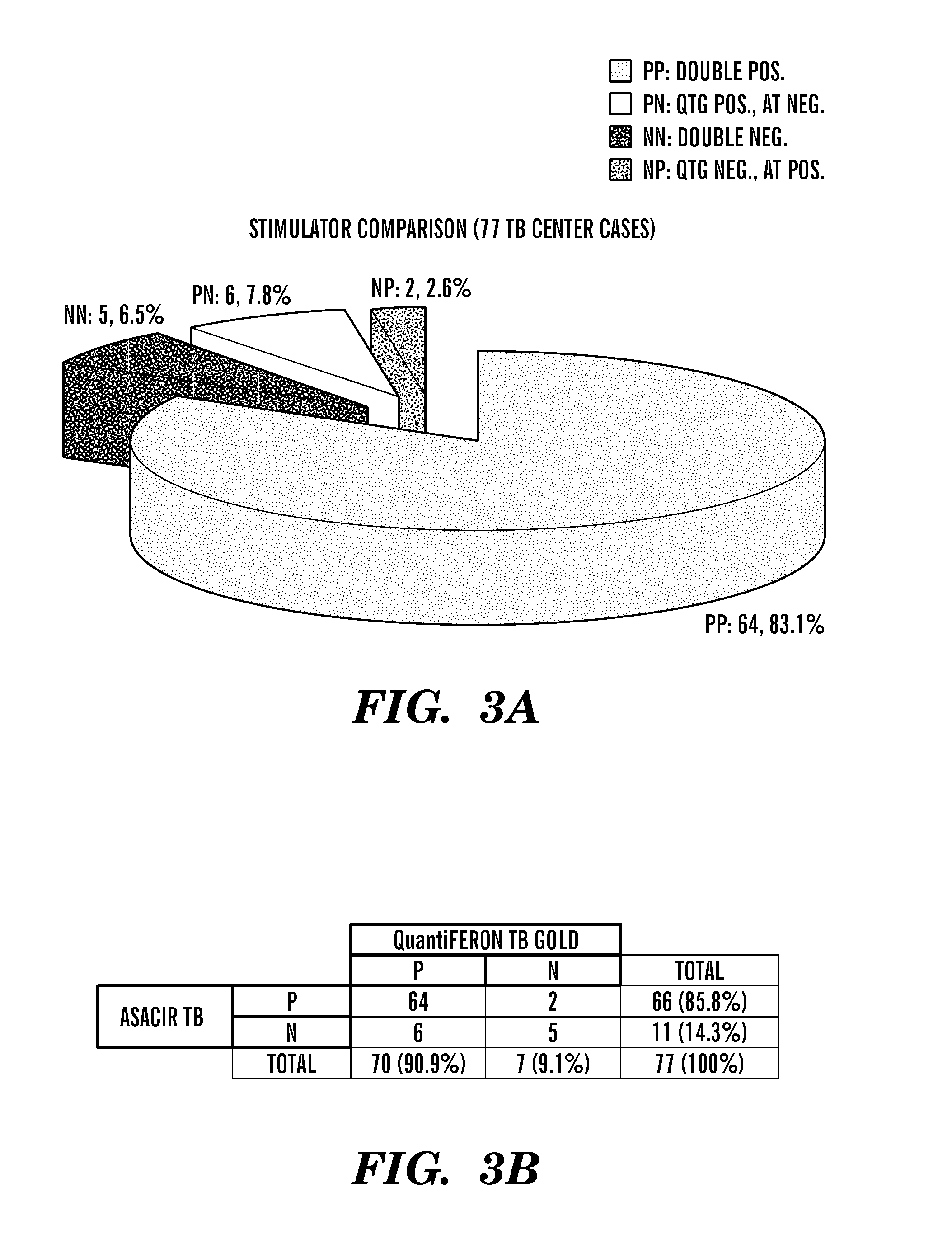Methods and compositions for diagnostic assays for measuring cell mediated immune response
a cell-mediated immune and assay technology, applied in the field of diagnostic assays, can solve the problems of low sensitivity (75-90%) in diagnosing a-tb, low specificity, and limited testing, and achieve the effects of less expensive and faster production of fusion proteins, reduced assay cost, and improved stability
- Summary
- Abstract
- Description
- Claims
- Application Information
AI Technical Summary
Benefits of technology
Problems solved by technology
Method used
Image
Examples
example 1
[0365]IFN-γ ELISA Procedure. As an example, the following describes the procedure for 1 plate (96 wells), with calculations based on 100 wells.
[0366]Coating: 10 μl of capture antibody (stock 1 mg / ml) is added to 10 ml of coating solution in order to dilute the capture antibody to 1 ug / ml. 100 μl of capture antibody at 1 μg / ml added to each well of a 96 well plate and incubated at 4° C. overnight. Following this incubation at 4° C., the capture antibody is aspirated from the wells, and the wells washed with 250 μl PBST / well at least three times, preferably 5 times. Following the washing steps, the wells are blocked, using 250 μl blocking buffer in each well for 2 hrs at 37° C.
[0367]Washing step: The blocking solution is aspirated from the wells, followed by addition of 250 μl PBST / well. This process is repeated for at least 3 times, preferably 5 times.
[0368]Sampling step: 100 μl IFN-γ of each of the standard curve dilutions (i.e. from 300 pg / ml to 4.7 pg / ml, see “Standard curve prepa...
example 2
[0375]Confirmation of TB smear test using CMI response assay in vitro. Samples from 13 patients identited to be positive for TB via TB smear test were assayed for CMI response to TB using the diagnostic test described herein. The 13 samples were also assayed for positivity for TB using the culture test. INF-γ levels were assayed using an ELISA after incubation with a LFn-TB antigen. The results are shown in Tables 3 and 4.
[0376]Table 3 shows an example of the results of the CMI assay as disclosed herein as a diagnostic and prognostic identification of subject with TB by measuring INF-γ levels using ELISA assay to determine the INFγ protein level.
SputumsputumsmearculturepostivenegativeVTI testSAMPLE IDpositivepositvecontrolcontrolsampleHLJT1217-1++0.0851.4961.920HLJT1217-2++0.0742.2770.240HLJ T1217-3+−0.1093.3422.809HLJ T1217-4+−0.0652.9330.641HLJT1217-5++0.0823.4832.628HLJ T1217-6+−0.0713.4082.020HLJ T1217-7+−0.0830.6840.110HLJ T1217-8+−0.0780.8252.861HLJT1217-9++0.1063.4062.678HLJ ...
example 3
[0380]As demonstrated herein, the ASCIR TB Test is better at accurately determining a subject with TB as compared to conventional tests. For example, as shown in FIGS. 15-17, the ASCIR TB test reduces the false postives for TB subjects, as compared to skin tests. The tuberculosis skin test (also known as the tuberculin test or PPD test) is a test used to determine if someone has developed an immune response to the bacterium that causes tuberculosis (TB). This response can occur if someone currently has TB, if they were exposed to it in the past, (or if they received the BCG vaccine against TB, which is not performed in the U.S.). In the TB skin test performed in FIGS. 15-18, the PPD test restults were analysed according to the following scale: a skin reaction of between 020 mm is a greater than strong reaction. Thus, the inventors demonstrated that the ASCIR TB test is more accurate in that it reduces the number of false postives identified as having TB.
[0381]For example, FIG. 15 co...
PUM
| Property | Measurement | Unit |
|---|---|---|
| pH | aaaaa | aaaaa |
| pH | aaaaa | aaaaa |
| volumes | aaaaa | aaaaa |
Abstract
Description
Claims
Application Information
 Login to View More
Login to View More - R&D
- Intellectual Property
- Life Sciences
- Materials
- Tech Scout
- Unparalleled Data Quality
- Higher Quality Content
- 60% Fewer Hallucinations
Browse by: Latest US Patents, China's latest patents, Technical Efficacy Thesaurus, Application Domain, Technology Topic, Popular Technical Reports.
© 2025 PatSnap. All rights reserved.Legal|Privacy policy|Modern Slavery Act Transparency Statement|Sitemap|About US| Contact US: help@patsnap.com



